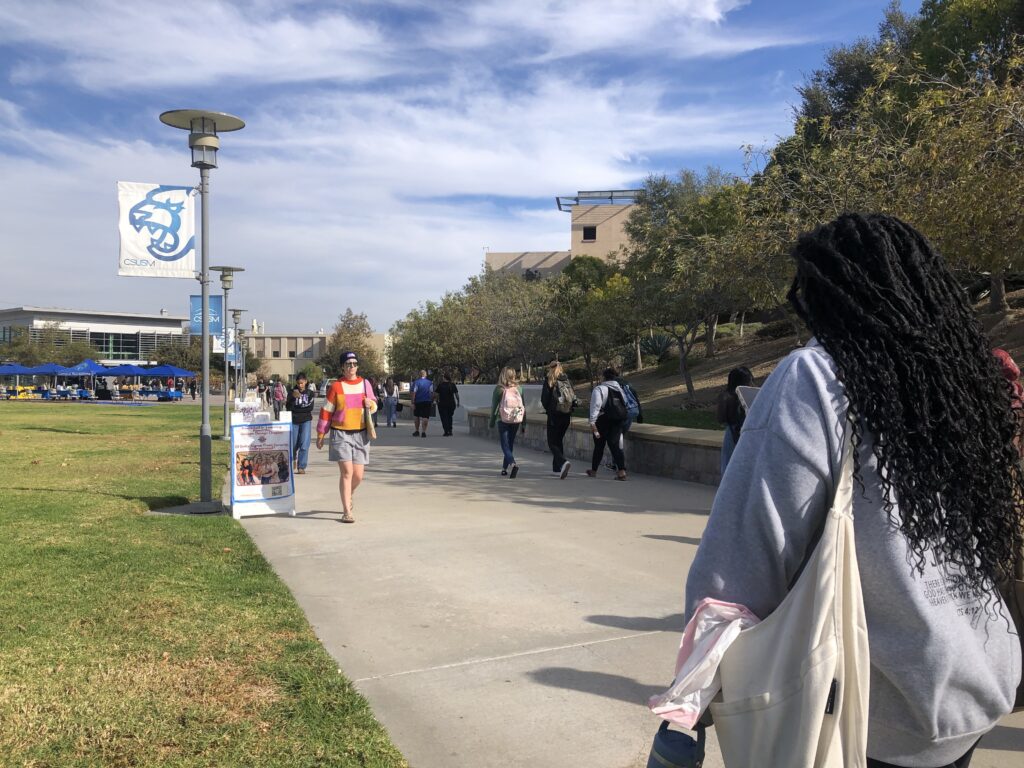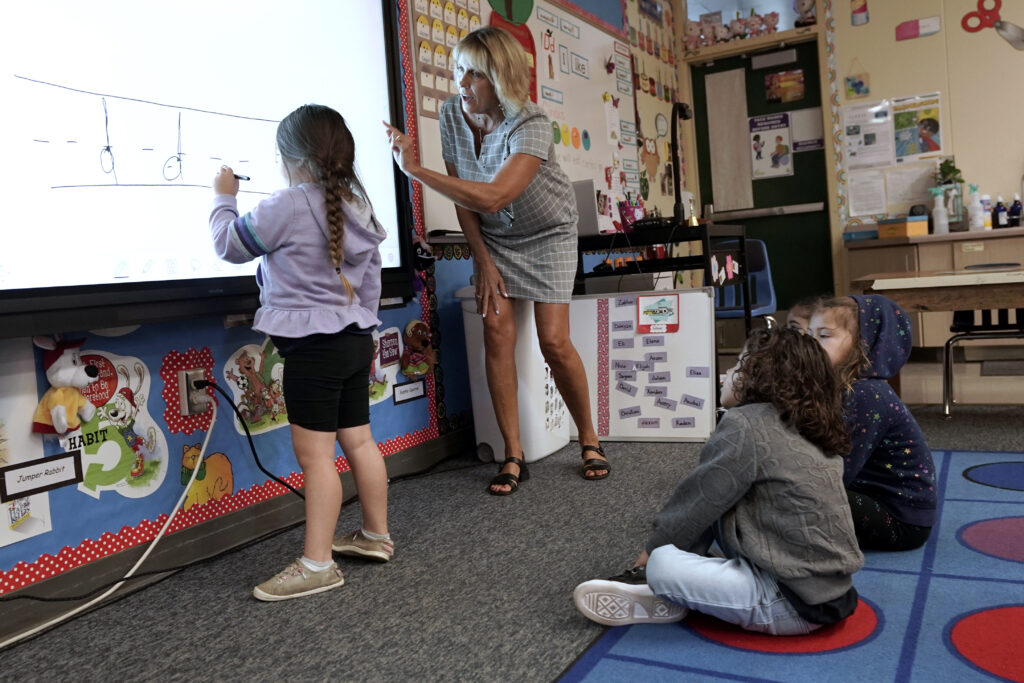
Students walking on the campus of Cal State San Marcos on Dec. 3, 2024.
Credit: Amy DiPierro / EdSource
Diego Lopez, a student in his last year at Cal State San Marcos, gives the north San Diego County campus high marks. The Army veteran likes his classes, feels the campus is generally well-managed and appreciates that at the school’s current size, “you can just chill, and relax, and not get too overwhelmed.”
But Lopez can tell the student body is expanding, especially at the start of the semester, when he has to navigate crowded parking lots.
“The parking lots are so full, so you have to make sure you get here early. And then just right across the street, you see all the construction being done,” he said. “You can definitely tell: This school is growing a lot, and it’s growing fast.”
The number of students at the suburban Cal State San Marcos campus has mushroomed over the past decade. It’s now home to 14,655 students, an almost 15% jump since 2015, among the sharpest increases of any Cal State campus in that period.
But that is not the case across the 23 campuses of the California State University system. Overall system enrollment has settled at 2.7% lower than a decade ago after tumbling more deeply during the pandemic. And behind that number is a more complicated picture, with some individual campuses showing double-digit percent increases even as others have experienced big decreases.
While San Marcos students have raced to find parking in the first weeks of recent academic years, Sonoma State students in contrast can usually find dozens of empty spaces in the Bay Area school’s main parking lot. The campus has suffered the worst enrollment loss in the university system, contracting from 9,408 students in 2015 to 5,784 students in 2024. Recent statistics suggest it had the highest dorm vacancy rate in the Cal State system in spring 2023, prompting the university to open some housing to nonstudents.
Falling enrollment has prompted a period of tight finances at the Sonoma State campus. Tess Wilkinson, a fourth-year transfer student studying communications, said she saw fewer courses being offered. She suspects budget cuts are one reason why.
“I even noticed some professors that had regularly taught courses in my major were no longer on the course schedule at all,” she said. “Some courses were thrown together to accommodate abrupt faculty changes — and student engagement in my classes felt like it had decreased.”
The divergence between San Marcos and Sonoma shows how the enrollment challenge facing the nation’s largest university system defies a one-size-fits-all solution about how to serve students and where to spend money around the state.
The trend continued this fall, with enrollment up from the year before at 15 campuses and down at eight. That uneven distribution of new students is in part due to regional differences in population, the cost of living and labor markets. It may also reflect whether they cater primarily to commuters or on-campus residents, offer higher- or lower-demand degrees and serve more or fewer students sensitive to last year’s federal financial aid delays.
Enrollment at community colleges, a major feeder into Cal State, also slipped during the pandemic, though student headcount has started to recover. Going forward, Cal State will have to grapple with a long-predicted decline in the number of recent high school graduates in California. The Public Policy Institute of California, a think tank, nonetheless projects that CSU enrollment will continue an upward trajectory through 2035, thanks to larger shares of high school students completing college preparatory courses and higher college-going rates.
Even in a year when enrollment across the Cal State system rose a modest 1.5%, some campus leaders enjoyed a banner college acceptance season. Cal State Monterey Bay, whose 16% enrollment bump was the system’s largest 2023-24, sold out on-campus housing for the first time in a decade this fall, according to Ben Corpus, its vice president for enrollment management and student affairs.
At the other extreme, lower-enrolled CSU campuses must contend with the financial fallout from less revenue from tuition and fees. Sonoma State and Cal State Los Angeles, which notched the largest year-to-year enrollment drop in the system, have instituted hiring freezes and cut course sections to bridge funding gaps.
Starting this school year, Cal State also has reallocated funding to universities that exceeded enrollment targets or showed they have higher demand and away from those with dropping enrollments. Anticipated cuts in state funding because of overall state budget conditions may have additional ripple effects, even at campuses with flourishing student bodies.
Those stakes have not escaped the notice of campuses at both ends of the enrollment yo-yo. EdSource interviewed students, faculty and administrators at Sonoma State and Cal State San Marcos about how they think course offerings, student clubs, construction and, yes, parking are changing as their schools get bigger or smaller.

Sonoma State
An hour north of San Francisco, Sonoma State University celebrates its location on the edge of the Russian River Valley by naming its dorms for wine varietals and regions from Beaujolais to Zinfandel.
But wildfires have destroyed thousands of homes in this region of the state since 2017, a shock from which its population and already expensive housing market are still recovering. That has made it harder to recruit students from other parts of the state, who are a significant part of the student body, officials said. Sonoma State’s enrollment has slid almost 39% since 2015. Cal State’s 2022-23 financial statements put the school’s average residence hall occupancy at just 65%. The university has opened some of its student housing to faculty, staff, students with young children or even people visiting campus for a conference.
Collapsing enrollment over the decade slowed to a 1% dip this year. Still, the smaller student body has prompted a serious cash crunch. Sonoma State, which has a $130 million operating budget this school year, anticipates a $21 million budget deficit going into 2025-26.
“It’s pretty simplistic sort of math: We just don’t have enough students paying the tuition to fully cover all of the expenses we have,” Emily F. Cutrer, the university’s interim president, said at an Oct. 28 town hall to discuss Sonoma State’s budget forecast.
Cutrer said the university would have to add more than 3,000 students — a 52% increase over fall 2024 — to cover its current deficit, a goal she estimated is likely three or four years away. The loss of tuition and fee revenue is compounded by rising employee benefits costs, state funding cuts and an estimated $3.6 million that Cal State is expected to reallocate to other campuses.
Sonoma State is under a hiring freeze and is also pressing pause on some travel. The campus in recent years has offered employees early retirements and buyouts. Part-time and full-time lecturer headcount has fallen almost 25% in the last several years, a spokesperson said. Sonoma State notified the faculty union in October that layoffs could be on the way.
“I would ask people to stop asking us to do more with less. It’s exhausting,” Lauren S. Morimoto, who chairs the university’s department of kinesiology, said at the town hall. “We’re demoralized and we’re burnt out.”
Sonoma State’s struggles are a comedown from a campaign under then-President Ruben Armiñana to bill the university as a “public Ivy” – offering plush new facilities at a state university price – in the 1990s through 2010s. Armiñana’s critics charged that the strategy attracted a wealthier and whiter student body compared with the state’s other public universities.
Judy Sakaki succeeded Armiñana in 2016 with the explicit goal of making Sonoma State more accessible and less elitist. Sakaki’s 2022 resignation ushered in a period of leadership turnover; Cutrer is the third person to lead the university since then.
Tim Wandling, who chairs the English department and serves on the board of the California Faculty Association at Sonoma State, said he’s concerned about leadership instability on campus. He also worries that the university’s top brass “want to spend hundreds of thousands of dollars on marketing blitzes and new programs, and what they really need to do is just downsize their administrative staff and focus on keeping the good faculty that they have, the good students they have.”
Sonoma State is not alone among Bay Area universities hurting for students. San Francisco State and Cal State East Bay are facing similar declines.
Sonoma State’s relative distance from major population centers has long encouraged admissions staff to look outside their own backyard for prospective students.
Sonoma currently draws 35% of its students from its home county, an additional 63% from elsewhere in California and 1.6% from out of state. University administrators and attendees speaking at the October town hall appeared to favor an all-of-the-above recruitment strategy.
Locally, the campus has struck guaranteed admissions deals with several of the region’s school districts and community colleges. And looking outside Sonoma State’s immediate region, the university is also recruiting in Southern California, looking at ways of retaining students it already has and bringing back students who do not immediately re-enroll each term.

Cal State San Marcos
On a mild December afternoon, Cal State San Marcos student Diana Ortega Caballero was reading a book on a terrace overlooking construction cranes. Building sites are among the most visible cues of how the campus is expanding after some pandemic dips.
Ortega Caballero, a transfer student from MiraCosta Community College in nearby Oceanside, said she had “a really easy transition” to San Marcos. Almost a third of San Marcos students start at a California community college.
San Marcos is in good company among Southern California’s CSU campuses that have welcomed more students over the past decade due to regional population growth. San Diego State University is leading the system in enrollment gains since 2015, followed closely by Cal Poly Pomona and San Marcos.
Campus leaders have also taken concrete steps to steer more students to campus. Administrators have signed a series of guaranteed admissions agreements with school districts and other local education entities. They’ve also coordinated coursework with Murrieta Valley Unified School District and Mt. San Jacinto College to aid students earning software engineering degrees.
Students interviewed at the campus said they’re largely satisfied with San Marcos. Several noted that the campus feels more accessible than larger CSU campuses. But they conceded experiencing occasional snags as the campus expands, like trouble getting into certain classes or a long wait time to see an academic adviser.
Jackson Puddy, who is studying business administration, was standing outside the library waiting for students to arrive for a pickup chess game. He hoped the school’s growing enrollment would bring more money, more professors and perhaps even more members for the small chess club he runs. The only con? “The parking situation — it’s not going to get any better,” he said, even if students can now reliably find a space in a dirt lot downhill from the main quad.
Students recently approved a $210 per-semester fee increase to fund a new wellness and recreation center. Plans call for a turf field on a rooftop deck, indoor courts, cardio and strength training facilities and 550 beds for student housing. In addition, the campus opened a new dorm for 300 students two years ago and is currently building another one for 500.
Cal State system statistics suggest San Marcos has some of the busiest classroom and laboratory space of any school in the CSU system. One of the school’s most urgent goals is to meet surging demand for its engineering program, which began in 2019 with 300 students and has ballooned to 2,000. Campus leaders plan to build a three-story, $110 million building to house its College of Science, Technology, Engineering and Mathematics. The project is expected to break ground in July 2025.
San Marcos’ growth does not immunize it from the belt-tightening other CSU campuses have begun in anticipation of lower state funding. At a board of trustees meeting in September, President Ellen Neufeldt said a lack of additional faculty could lead to larger class sizes and noted that the school has deferred maintenance on aging electrical systems.
“The challenge we now face is that while we are growing, we are unable to hire the essential employees needed to support our mission of student success,” Neufeldt said. “We urgently require more advisers, success coaches, tutors, financial aid specialists and counselors, and the list goes on and on, to assist our amazing students.”
Ally Valiente, a student at Sonoma State University and a member of the Student Journalism Corps, contributed to this story.





